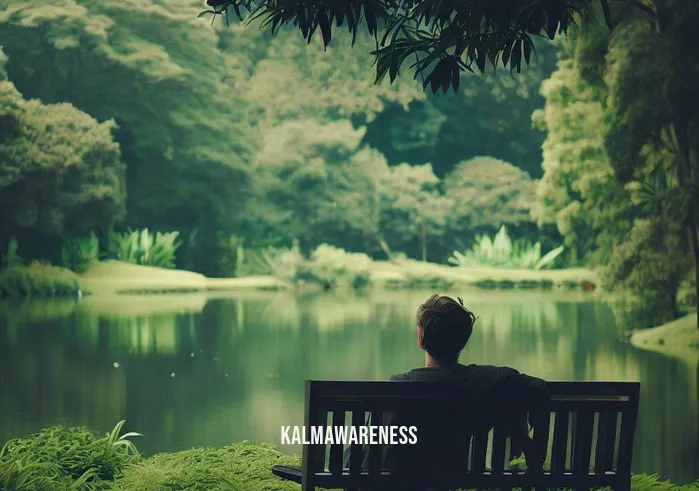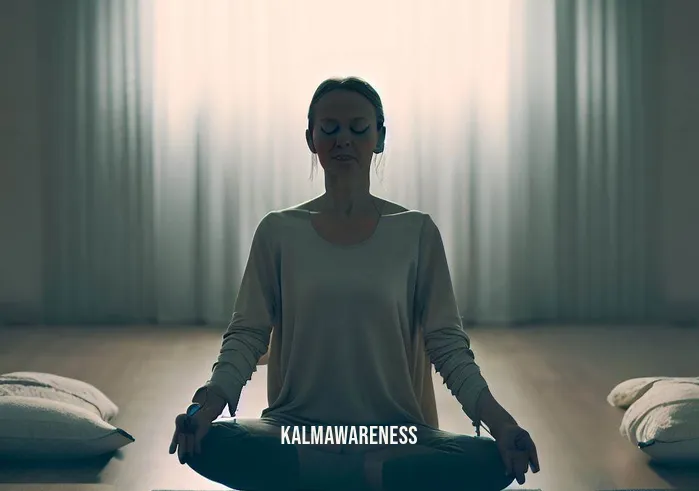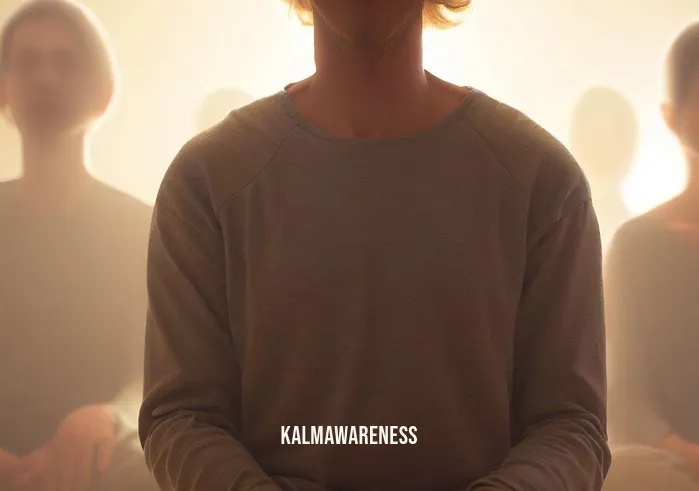Principles of Meditation: Embarking on a Mindful Journey
The human experience is marred with constant hustle and bustle. The noise, the chaos, the daily obligations, they all come together to make us lose touch with our inner selves. But, the journey back to oneself isn’t as convoluted as one might imagine. The principles of meditation can act as a guiding light, illuminating the path of mindfulness, peace, and present moment focus.
What is Meditation?
Meditation is the practice of turning inward, of focusing the mind and finding a point of balance. It’s not just about sitting silently with closed eyes, but a deeper immersion into the self.
Sense awareness is a pivotal point to start understanding meditation. It refers to being in tune with our surroundings and the sensations they evoke. This heightened sense helps us observe without bias, without judgement. Speaking of judgment, one must learn the art of meditating without judgment, a core principle that teaches us to experience without letting preconceived notions color our perceptions.
Three Pillars of Mindfulness
The term ‘mindfulness’ is often interchanged with meditation. Though closely related, they aren’t the same.
Breath Awareness
Breath – the life force, the constant ebb and flow that sustains us. Being aware of one’s breath is an entry into the world of mindfulness. It’s often said that when lost, one should let awareness follow the breath home. The Anapana technique further delves into the mysteries of breath and its relationship with our mind.Present Moment Focus
Living in the present might sound cliched, but its profundity cannot be understated. Presence meditation epitomizes this principle, teaching us to be in the here and now, soaking every moment without being swayed by the past or the future.Non-Judgment
To observe without judgement is to see things in their true essence. Judgement clouds perception and leads to a skewed understanding of reality. This principle reminds us to be impartial observers, just as the esteemed Brene Brown advocates for in her perspectives on mindfulness.
A beautiful adage goes – “Judge no one, just improve yourself”. This resonates deeply with meditation. Dive deeper into this concept here.
Techniques to Aid Your Practice
There are numerous techniques to assist practitioners on this path. The technique of smelling the rose and blowing out the candle aids in enhancing breath awareness. Meanwhile, anchor breathing stands as a testament to the calming effects of deep, focused breathing.
Visualizations like the breath images can also provide a tangible way for beginners to grasp abstract concepts.
If one is looking for a comprehensive guide, understanding the three components of mindfulness lays a solid foundation. Additionally, for those who wish to delve into more advanced practices, choiceless awareness meditation stands out.
Conclusion
Meditation isn’t just a practice; it’s a way of life. It beckons one to cultivate inner peace, to be compassionate, and to lead a life that’s centered and balanced. The body compassion definition is an embodiment of such teachings, guiding individuals towards a holistic understanding of themselves and the world.
The journey of meditation is vast and deep, yet the steps are simple. By understanding and imbibing the core principles of meditation, one paves the path for a mindful and enriched life.
I invite you to continue to the next part of this article where we’ll delve deeper into the nuances of these principles, their applications, and the transformative power they hold. Onward to a more mindful you!

Exploring Deeper: Advanced Principles of Meditation
Having laid the foundation in understanding the rudiments of the principles of meditation, our journey continues into deeper waters. These advanced principles delve into intricate aspects of the self and consciousness, providing a comprehensive roadmap for those looking to take their meditation practices to the next level.
The Nexus between Mind, Body, and Environment
The fundamental realization that our mind, body, and the environment are intricately interconnected can deeply enhance the meditation experience. Our body compassion definition offers a hint into this, suggesting a deep bond between our internal and external worlds.
Understanding the Components
Mind:
This encompasses our thoughts, emotions, and mental faculties. It’s the seat of our consciousness. The understanding that mindfulness has three major components can provide clarity on navigating its complexities.Body:
More than just a physical entity, the body is the vessel that experiences sensations, energies, and the effects of our mental states. To truly harness the principles of meditation, one should tap into the art of reminder to breathe, using the body as a gateway to inner peace.Environment:
It plays a vital role in shaping our meditation experience. The sounds, the ambiance, and the energies of our environment either enhance or hinder our meditation journey. There’s a reason why certain environments, like those near nature, are considered more conducive to meditation.
Tools for Deepening the Connection
Guided Meditations:
Using auditory aids, these meditations guide the practitioner through a narrative or visualization. They often encompass teachings from seasoned meditators and can be a bridge between the beginner and advanced levels.Tactile Tools:
Objects like beads, cushions, or even specialized clothing can enhance the physical experience of meditation. It’s the essence behind the practice of awareness following the breath home, using tactile sensations to ground oneself.Visual Aids:
Mandalas, symbols, or even candle flames can be used to focus the mind, giving it a singular point of concentration.
Benefits: A Quick Overview
To understand the profound impact of these advanced principles, let’s delve into a table that lays out the myriad benefits:
| Aspect | Benefit | Related Link |
|---|---|---|
| Emotional Regulation | Stability and reduced emotional volatility | What are the 3 qualities of mindfulness? |
| Enhanced Concentration | Sharper focus and clarity | The easiest way to get into the meditative state |
| Physical Health | Lowered stress, improved sleep | Anapana |
| Spiritual Growth | Deepened connection to the universe | Choiceless awareness meditation |
| Interpersonal Relationships | Better understanding and compassion | Observe without judgement |
In Conclusion
As we progress in understanding and internalizing the deeper principles of meditation, it becomes evident that meditation is not a mere activity. It is an ever-evolving journey of understanding oneself and the universe. By exploring these advanced principles and integrating them into our daily practices, we can aspire to reach new pinnacles of consciousness and self-awareness.
In the next chapter, we’ll delve into the challenges faced during this journey and practical tips to overcome them, ensuring a seamless and enriching meditation experience. Dive in to uncover strategies, anecdotes, and insights to elevate your meditation journey!

Challenges and Triumphs: Walking the Path of Meditation
Embarking on the journey to understand the principles of meditation is much like navigating the vast expanse of an ocean. While the waters may sometimes be calm and serene, at other times, they might be tumultuous and challenging. This chapter sheds light on the common challenges faced by meditation practitioners and the means to triumph over them. As we navigate these challenges, the wisdom of famous quotes can serve as guiding stars to keep our spirit high and determined.
Challenges on the Path
1. The Wandering Mind
The mind is often likened to a monkey, incessantly jumping from one thought to another. For many, achieving a still mind is the most significant challenge. As we dig deeper into this, it becomes evident that understanding what constitutes the three components of mindfulness can provide tools to tether this wandering entity.
“All that we are is the result of what we have thought.” – Buddha
2. Physical Discomfort
Sitting in meditation, especially for beginners, can lead to physical discomfort. Aches, pains, and restlessness can be deterrents. Here, techniques like anapana can be instrumental in redirecting the focus from discomfort to the rhythm of one’s breath.
“The body benefits from movement, and the mind benefits from stillness.” – Sakyong Mipham
3. Skepticism and Doubt
Many grapple with skepticism, doubting the efficacy of meditation or their ability to practice it effectively. Delving into how to get into the meditative state easily can dispel some of these doubts, allowing one to experience the profound impacts first-hand.
“Do not let the behavior of others destroy your inner peace.” – Dalai Lama
4. External Distractions
From the external noise to the demands of daily life, numerous distractions pull one away from the meditative path. Cultivating an environment conducive to meditation, akin to the one discussed in the principles of meditation, can be a game-changer.
“Peace comes from within. Do not seek it without.” – Buddha
Triumphing Over Challenges
1. Regular Practice
Consistency is the key. Regular practice, even if for shorter durations, helps build the meditation muscle, making it easier to dive deep without distractions.
“Meditation brings wisdom; lack of mediation leaves ignorance.” – Buddha
2. Community and Guidance
Joining meditation groups or seeking guidance from seasoned practitioners can be immensely helpful. Shared experiences and collective energy often enhance the meditation experience. Delving into Brene Brown’s perspectives on mindfulness can also offer valuable insights.
“Alone we can do so little; together we can do so much.” – Helen Keller
3. Setting Intentions
Setting clear intentions before each meditation session acts as a compass, guiding the mind and keeping it from wandering aimlessly.
“The future depends on what you do today.” – Mahatma Gandhi
4. Embrace the Journey
Understanding that the path of meditation is a journey, not a destination, allows one to be patient and forgiving with oneself. Each session, each moment is a step forward.
“The journey of a thousand miles begins with one step.” – Lao Tzu
In Conclusion
The principles of meditation are not just about techniques or postures. They are about embarking on a transformative journey, one that’s replete with challenges and triumphs. While the challenges test our resilience, the triumphs reward us with unparalleled peace, wisdom, and growth. And, as we tread this path, let the wisdom of the sages, encapsulated in their timeless quotes, guide, and inspire us.
As we transition to the next chapter, we’ll focus on integrating meditation into daily life, ensuring that its essence permeates every aspect of our existence. Dive deeper to discover practical tips, routines, and inspirations to make meditation an intrinsic part of your day!

Integrating Meditation into Everyday Life
The principles of meditation are not limited to a cushion or a dedicated space. Its philosophy can weave into the very fabric of our daily lives, allowing us to live mindfully, authentically, and with deeper compassion. This chapter illuminates how to infuse meditation into everyday moments and cultivate a continuous stream of awareness, even amidst the whirlwind of life’s demands.
Morning Rituals: Start with Intention
Breath Awareness: As soon as you wake up, spend a few moments focusing on your breath. Experience the air flowing in and out, acknowledging its life-giving properties. A technique like breath imagery can amplify this practice.
Setting Intentions: Begin the day by setting clear intentions. Whether it’s staying calm during a meeting or practicing patience, such intentions keep us grounded.
Stretch and Move: Before diving into daily chores, stretch your body, perhaps with some yoga postures. This physical movement complements the stillness cultivated through meditation.
Mindful Daily Activities
Eating with Awareness
Transform meals into meditation sessions by:
- Observing the colors and textures of your food.
- Expressing gratitude for the nourishment it provides.
- Truly tasting each morsel, rather than mechanically consuming.
Mindful Commuting
Observation: Whether you’re driving, cycling, or walking, use commute times to practice mindfulness. Notice the surroundings, the changing scenes, and the rhythmic motion of the vehicle.
Sound Meditation: The hum of an engine or the rhythm of footsteps can be used as an anchor, akin to following the breath home.
Mindful Breaks at Work
During short breaks:
- Engage in a mini presence meditation session, even if it’s for just a couple of minutes.
- Practice anchor breathing to reset and recharge.
Cultivating Mindful Relationships
Active Listening: Instead of merely hearing, actively listen when someone speaks. This echoes the non-judgment principle, allowing us to understand others without clouding perceptions with our biases.
Expressing Gratitude: Just as we express gratitude for our food, extend it to relationships. Acknowledge and appreciate the roles everyone plays in your life.
Non-verbal Cues: Pay attention to body language, as it often communicates more than words. This practice aligns closely with understanding body compassion definitions.
Night Rituals: Closing the Day with Reflection
Gratitude Journaling: List down three things you’re grateful for every night. This simple act cultivates positivity and appreciation.
Body Scan: Before sleeping, mentally scan your body from head to toe. Recognize any tension and release it.
Review: Reflect on the day, not with judgment, but with an observer’s perspective. This helps in understanding oneself better and aligns with the practice of observing without judgment.
In Essence
The principles of meditation extend far beyond formal sessions. They are life principles that, when integrated into our daily routines, elevate our experiences, enrich our relationships, and endow us with a profound sense of peace. It’s not about setting aside time for meditation, but making every moment meditative.
As we delve into our next chapter, we will explore the deeper dimensions of meditation. Understand the metaphysical aspects, the science behind it, and how the ancient practices are more relevant today than ever before. Dive deeper to uncover the profound mysteries of the meditative mind.

The Timeless Essence of Meditation: Leaving an Imprint
It’s undeniable, the transformative power of the principles of meditation in molding an individual. Beyond just a practice, it’s a philosophy that seeps into one’s very core, affecting not just their actions but also their perspectives and worldviews. As we explore the closing chapter of this enlightening journey, let’s embrace the timeless essence of meditation and understand the long-lasting impact it has on our souls and the world around us.
1. Meditation: Beyond Time and Space
Meditation is not a modern trend. Its roots are entrenched in ancient traditions, spanning across cultures and generations. The very principles we delve into today, such as breathing techniques, are echoes from ancient practices that recognized the sheer power of the breath.
Yet, the beauty of meditation lies in its relevance. Even in our fast-paced, digital age, these ancient principles guide us to sanity, grounding, and an oasis of calm amidst the chaos.
2. Embracing Change: Meditation as a Constant
While everything around us is in a constant state of flux, the principles of meditation remain steadfast. They serve as anchors, reminding us of the impermanence of life and guiding us to embrace change with grace and acceptance. As one understands the three core components of mindfulness, they realize the vitality of being present, regardless of life’s unpredictability.
3. Spreading Ripples: Meditation’s Collective Impact
It’s not just about individual transformation. Every individual practicing meditation becomes a beacon of peace, sending out ripples of calm and harmony in their surroundings. This collective consciousness, driven by principles such as choiceless awareness, gradually shapes communities, societies, and eventually, our global narrative.
4. Keeping the Flame Alive
The culmination of our meditation journey doesn’t mean the end; it’s the beginning of a lifelong practice. Continue to explore, dive deeper, and expand your horizons. With resources like Anapana, you are equipped to nurture and cultivate your meditative practices further.
5. A Personal Ode to the Journey
This exploration of the principles of meditation has been enlightening. But remember, reading about meditation is like reading about swimming. The real essence is captured only when you dive in. So, embrace meditation, not just as a routine but as a way of life.
Closing Thoughts
Meditation is a treasure trove of experiences, insights, and profound transformations. Each session is an opportunity, a new canvas to paint our experiences, feelings, and aspirations. As you move forward, carry these principles of meditation close to your heart, let them guide your steps, and illuminate your path.
Thank you for walking this path with us, for exploring the depths and vastness of meditation. While this chapter concludes, remember, every ending is a new beginning. Keep the spirit of exploration alive. We invite you to continue diving deeper, reading more, and discovering the myriad facets of mindfulness, meditation, and inner peace in our extensive magazine collection. Here’s to a journey of enlightenment, self-discovery, and boundless inner peace.




